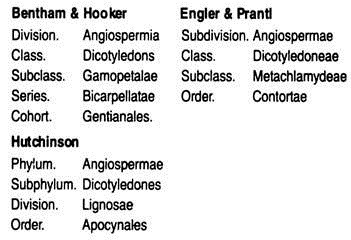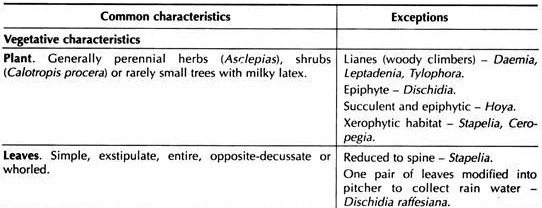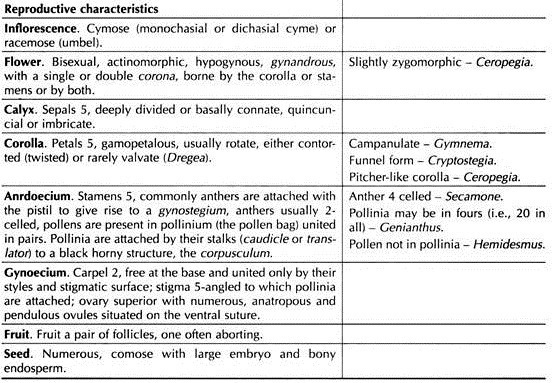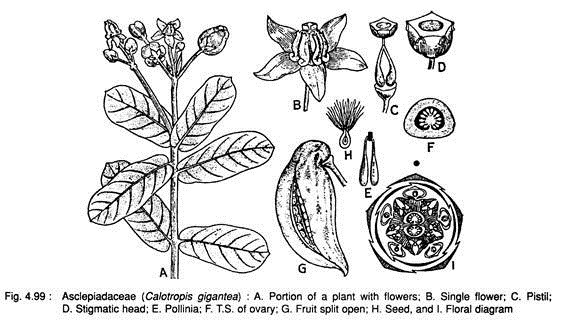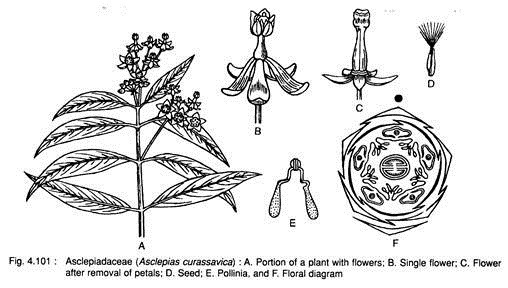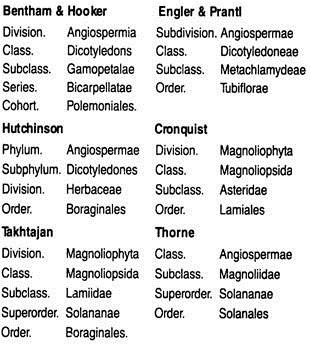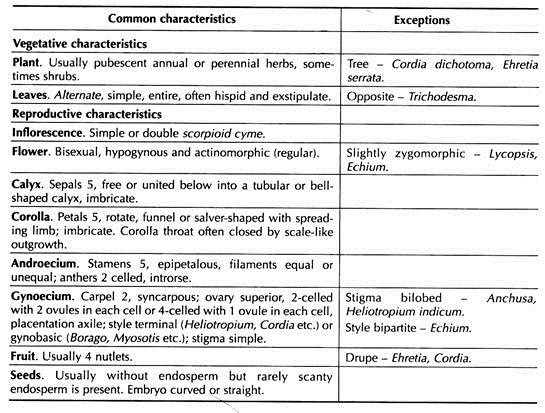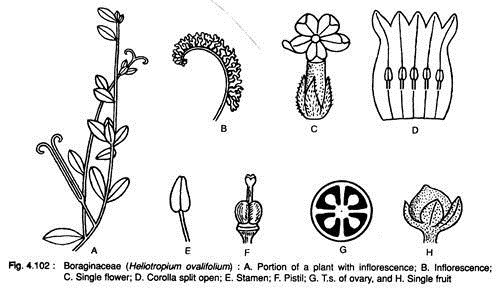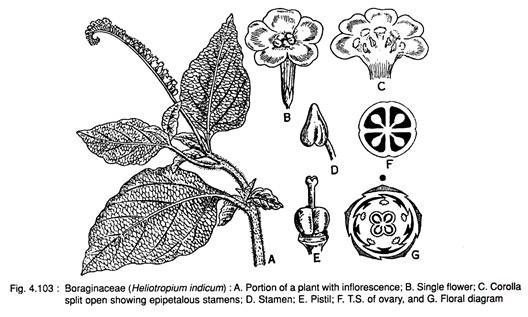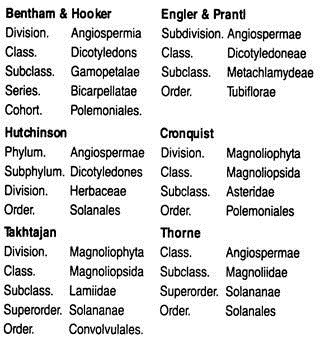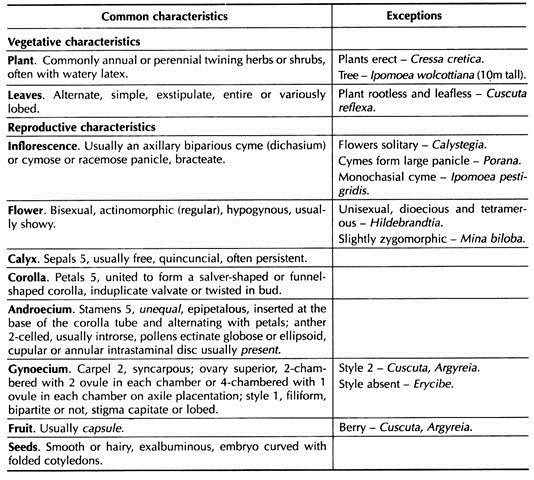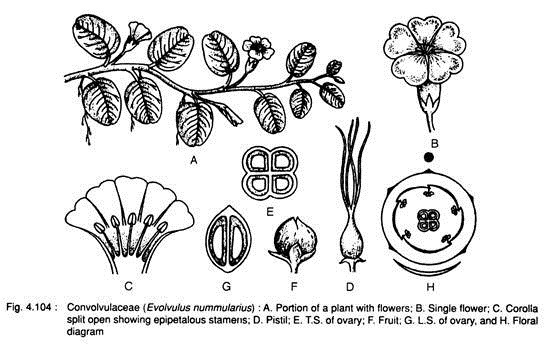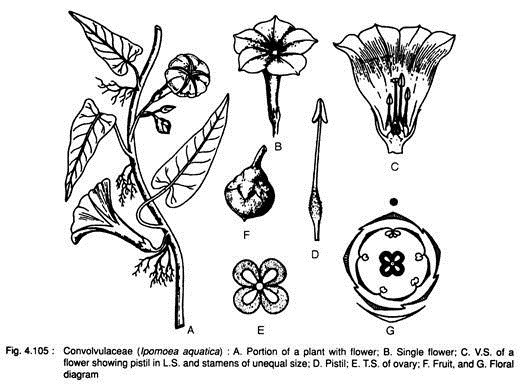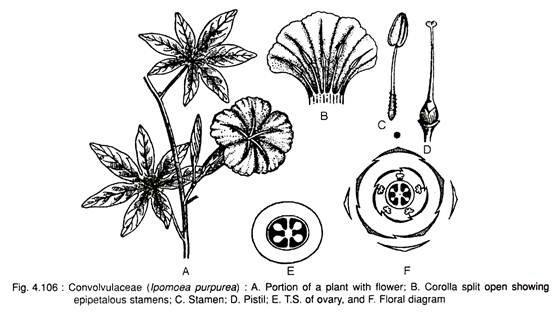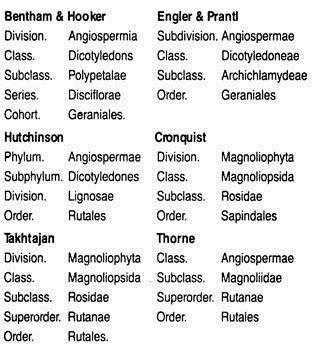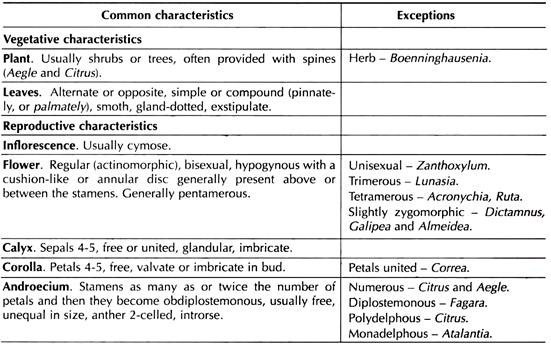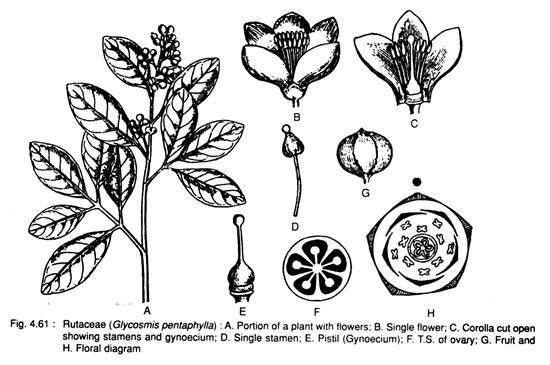Here is an essay on the ‘Families of Dicotyledons’ for class 11 and 12. Find paragraphs, long and short essays on the ‘Families of Dicotyledons’ especially written for school and college students.
Families of Dicotyledons
Essay Contents:
- Essay on Asclepiadaceae (Milkweed Family)
- Essay on Boraginaceae (Borage Family)
- Essay on Convolvulaceae (Morning-Glory Family)
- Essay on Rutaceae (Citrus Family)
Essay # 1
. Asclepiadaceae (Milkweed Family) :
The family Asclepiadaceae is represented by about 175 genera and more than 2,200 species which grow widely in the tropical and subtropical parts of the world; out of which 53 genera and about 250 species are available mostly in the tropical Himalayas and Western and Southern parts of India.
The type genus of the family is Asclepias.
Systematic Position:
The family Asclepiadaceae has been merged with Apocynaceae by modern taxonomists like Thorne (1983), Takhtajan (1997), etc., giving the rank of a subfamily, Asclepiadoideae.
Identifying Characteristics:
1. Plants commonly herb or shrub with milky latex.
2. Flower bisexual, regular, hypogynous and pentamerous.
3. Stamens 5, adnate to pistil forming gynostegium. Pollen grains are in pollinia.
4. Ovary superior, Carpels 2, free at the base and united by their styles; stigma discoid and 5-angled.
5. Fruit a pair of follicle.
Asclepiadaceae: Distinctive Features:
Floral Formula:
Phylogeny and Systematic:
The family Asclepiadaceae is very much related to and advanced than Apocynaceae, makes the difference mainly in presence of gynostegium and pollinia.
Bentham and Hooker placed the natural order Asclepiadaceae under Geraniales, series Bicarpellatae, subclass Gamopetalae and class Dicotyledons. He divided it into two subfamilies Periploceae (e.g., Periploca, Cryptolepis etc.) and Euasclepiadaceae (e.g., Calotropis, Asclepias etc.). Engler placed the family under the order Contortae under the subclass Metachlamydeae.
But Hutchinson (1969) placed it under Apocynales order of subclass Metachalmydeae. Thorne (1983), Takhtajan (1987, 1997), and others abolished the status of Asclepiadaceae family. They merged this family with Apocynaceae giving a status of subfamily, Asclepiadoideae.
Common Plants:
1. Asclepias curassavica L.;
2. Boucerosia aucheriana Decne.;
3. Calotropis gigantea R. Br.;
4. C. procera R. Br.;
5. Cryptolepis buchanani R. & S.;
6. Cynancbum callialata Ham.,
7. Decalepsis hamiltoni W. & A.;
8. Dischidia raffesiana Wall.;
9. Finlaysonia maritima Backer;
10. Hemidesmus indicus R. Br.;
11. Hoya parasitica Wall.;
12. Marsdenia volubilis Cooke (Syn. Dregea volubilis Benth.);
13. Oxystelma esculentum R. Br.;
14. Pergularia daemia Chois (Syn. Daemia extensa R. Br.);
15. Sarcolobus globosus Wall;
16. Tylophora indica Merr. (Syn. T. asthmatica W. & A.) etc.
Key to Genera:
I. Filaments free; anthers acute or appendicular; pollinia granular, in pairs in each cell:
1. Coronal scales coralline, free, short, thick; seeds with coma …
i. Corolla small, rotate, lobes valvate ……….. Hemidesmus.
ii. Corolla small, rotate, lobes overlapping…………. Cryptolepis.
iii. Corolla large, funnel-shaped, lobes overlapping ……………. Cryptostegia.
2. Coronal scales filiform, 5, free, close to or adnate to the filaments …
i. Corolla-lobes short and broad; filaments without intervening glands; seeds without coma; flowers in pubescent stout cyme … Finlaysonia.
II. Filaments connate; anthers with membranous tips inflexed; pollinia waxy, single in eadh cell, sessile or pedicelled in pairs, usually pendulous:
1. Coronal appendages double, outer coralline and inner staminal, with ligulate scales
i. Corolla wide rotate-campanulate, angularly 5-lobed; plant usually a twiner ………… Oxystelma.
ii. Corolla campanulate; processes of inner corona free from smooth staminal tube …………..Cynanchum.
2. Coronal appendages single (or while double both are staminal) …
i. Corolla wide campanulate; staminal corona radiating and laterally compressed, spurred on the back; plant erect …………………… Calotropis.
ii. Corolla rotate; coronal processes staminal. spoon-shaped; ligulate at the face ……………… Asclepias.
iii. Corolla twisted, rotate; outer coronary scales cupular, membranous and the inner ones erect with a dorsal ligulary processes connecting the anthers……………………. Sarcostemma.
3. Coronal appendages or only corona suppressed…
i. Corolla rotate, outer corona absent or rudimentary with larger or only lobes opposite the anthers ……………. Pentatropis
ii. Corolla funnel-shaped; outer corona conspicuous, 5-10-lobed, laterally compressed; stem twining … Daemia.
iii. Corolla campanulate, twisted, lobes short; corona 0; stem twining…………….. Sarcolobus.
iv. Corolla funnel- or salver-shaped; coronary scales erect or rarely absent; climbing shrub ………….. Stephanotis.
v. Corolla campanulate or salver- shaped; coronal scales on the back of the anthers, simple ………………….. Marsdenia.
vi. Corolla rotate or salver-shaped; coronal scales on the back of the anthers, notched; flowers yellow or orange ……….. Pergularia.
vii. Corolla rotate; coronal processes fleshy; stamens originating from the throat of the corolla-tube…Tylophora.
viii. Corolla rotate, green; coronal scales spreading in stellate processes, fleshy and thick; flowers in pendulous umbel …………. Dregea.
ix. Corolla rotate; coronal processes large; stellate anthers occasionally without membraneous tip……… Hoya.
x. Corolla urceolate; scales of corona erect, membranous …………… Dischidia.
Plants of Economic Importance:
The plants of this family are important as ornamental and drug plants; a few are also used for other purposes.
A. Ornamental Plants:
Asclepias curassavica, Ceropegia woodii, Cryptostegia grandiflora (Rubber-vine), Hoya parasitica and Stapelia gigantea are grown as ornamental plants.
B. Medicinal Plants:
1. Cynanchum arnotianum. The plant is used as insecticide.
2. Gymnema sylvestris. It is used to control stomachi, as laxative and diuretic. The plants are used to control cough, sore eyes and biliousness.
3. Hemidesmus indicus R. Br. (E.Indian sarpaparilla, B. Anantamool). The dried roots are used to control skin and urinary diseases, chronic rheumatism and as blood purifier.
4. Sarcostema acidum. Infusion of the roots is used as antidote for snake bite.
5. Tylophora indica (Indian Ipecacuanha). The roots are used for the treatment of whooping cough, bronchitis and asthma.
C. Other Uses:
1. Asclepias curassavica, Calotropis gigantea, Cosmostigma racemosa, Marsdenia roylei, Leptadenia pyrotechnica. The phloem fibre (bast fibre) obtained from the stem is used in making fishing net, twines, cordage etc.
2. Calotropis procera and C. gigantea. The latex of both the plants is used for removing hairs, for deodorising in tanning industry.
3. Cryptostegia grandiflora R. Br. (rubber- yielding plant). The latex of the stem is the commercial source of rubber.
4. Gymnema latiferum L. The milky latex of the plant is edible. The plant is found in Sri Lanka (Ceylon).
Essay # 2
. Boraginaceae (Borage Family) :
The family Boraginaceae is represented by about 117 genera and 2,400 species commonly found to grow in the tropical and temperate regions of the world. Many members are available in the Mediterranean region. The family is represented in India by about 37 genera and 152 species found to grow chiefly in the temperate and alpine region of Himalayas and also in different dry regions of northern, southern and western regions of India.
The type genus of the family is Borago.
Systematic Position:
Identifying Characteristics:
1. Plants are commonly herbs.
2. Aerial parts (stem and leaves) are clothed with hairs or bristles.
3. Inflorescence scorpioid cyme.
4. Flowers bisexual, regular and hypogynous.
5. Leaves simple, extipulate, arranged alternately.
6. Stamens 5, equal or unequal, epipetalous.
7. Carpel 2, syncarpous, ovules on axile placentation. Style terminal or gynobasic.
8. Fruit usually of 4 nutlets.
Floral Formula:
Boraginaceae: Distinctive Features:
Phylogeny and Systematic:
The family Boraginaceae is closely related to Labiatae (Lamiaceae) and to some extent to Solanaceae. The family Boraginaceae has gynobasic style and deeply-cut nutlets. It shares these characteristics with Lamiacaeae and Verbenaceae. These characteristics may have been developed independently in all the 3 families from similar ancestors.
The family has been divided into 4 subfamilies based on style and fruits. These are Cardioideae, Ehretiodeae, Heliotropiodeae and Boraginoideae. Hutchinson (1969) kept the last two subfamilies in Boraginaceae and first two with woody genera were placed in a separate family Ehretiaceae.
However, Takhtajan (1980) accept the family by retaining the components of all the 4 subfamilies. Cronquist (1981) also followed the same principle. Bentham and Hooker and also Takhtajan placed the Boraginaceae in the order Polemoniales but Engler placed it under Tubiflorae.
Common Plants:
1. Cordia dichotoma forst. f. – a small tree;
2. Coldenia procumbens L.;
3. Cynoglossum procumbens Forst.;
4. Ehretia serrata Roxb. (Syn. E. acuminata R. Br.) — a large tree found in North Bengal;
5. Heliotropium indicum L.;
6. H. ovalifolium Forsk;
7. Trichodesma indicum R. Br. etc.
Key to Genera:
I. Style Terminal:
1. Style 2-partite on ovary; fruit a drupe with four 1-seeded stone; calyx enlarging in fruit; usually trees or shrubs …………. Cordia.
2. Style 2-fid at the apex; pyrenes 2 or 4 or rarely 1-seeded; trees or shrubs …Ehretia.
3. Style more or less separate; pyrenes 4, 1- seeded; prostrate herbs………… Coldenia.
4. Style filiform; stamens 5, anthers lanceolate conniving in a cone; calyx enlarged in fruit; ovary deeply 4-lobed and 4-celled; fruit pyramidal; erect herbs…Trichodesma.
5. Style on entire ovary, dilated at the apex or above the base; plants herbaceous…………… Heliotropium.
II. Style Gynobasic:
Flowers all sessile or only the lower ones perdicelled; stamens included; nutlets obovoid, glochidiate, depressed……………… Cynoglossum.
Plants of Economic Importance:
The plants of this family are of various uses. They are used as edible, ornamentals, medicines and also have other uses.
A. Edible Fruits:
Ehretia acuminata. The ripe fruits are edible.
B. Vegetable:
Cordia dichotoma. The unripe fruits are used as vegetable.
C. Ornamental Plants:
Cordia sebestena L. (tree with orange red flower), Heliotropium arborescens L. (a herb), Myosotis palustris (Forget-me-not plant of Europe, is available in Himalayas), Borago (Borage), Echium (Viperis bugloss), Cynoglossum (Houndis tongue) etc. are grown as ornamental plants.
D. Medicinal Plants:
1. Ehretia macrophylla. The roots are used as an antidote for vegetable poisoning.
2. Heliotropium indicum. The decoction of leaf is used in fever and root in cough.
3. H. strigosum. The plants have both diuretic and laxative properties.
4. Lithospermum arvense (Corn gromwell). The extract of the plant paralyses the central nervous system due to the presence of an alkaloid cynoglossine.
5. L. officinale (Gromwell). The decoction of seeds is used in gout and diseases of bladder.
6. Onosma bracteatum. The dried leaves and flowers contain the drug gaozaban. Gaozaban is used as tonic, diuretic, refrigerant etc.
E. Plants of Other Uses:
1. Alkanna tinctoria. A red dye “alkanet” is extracted from the roots.
2. Arnebia hispidissima and Onosma hispida. The roots are the source a red dye, “ratanjot”; used for colouring foods and also used in the preparation of medicines.
3. Ehretia laevis. The wood is used for match boxes, brush-backs etc.
4. E. wallichiana. The wood is used for making tea boxes and also for building purposes.
Essay # 3
. Convolvulaceae (Morning-Glory Family):
The family Convolvulaceae is represented by about 55 genera and 1,930 species found to grow chiefly in the tropical and subtropical regions of the world. The family is represented in India by 20 genera and about 158 species found to grow chiefly in the western and southern regions.
The type genus of the family is Convolvulus.
Systematic Position:
Identifying Characteristics:
1. Plants are usually twining herbs, sometimes shrubs or undershrubs.
2. Flower bisexual, regular, hypogynous and pentamerous.
3. Corolla funnel-shaped or salver-shaped.
4. Stamens 5, unequal in size.
5. Ovary superior, Carpels 2, 2-celled, 1 or 2 ovule on axile placentation.
6. Fruit usually capsule.
Convolvulaceae: Distinctive Features:
Floral Formula:
Phylogeny and Systematic:
The family is closely related to Solanaceae and placed it under different orders by different taxonomists. It was placed under Polemoniales by Bentham and Hooker, Takhtajan; Tubiflorae by Engler and Prantl and Solanales by Hutchinson.
Bentham and Hooker placed the order Polemoniales under series Bicarpellatae, subclass Gamopetalae of the class Dicotyledons.
Takhtajan placed the order Polemoniales under the subclass Asteridae of class Magnoliopsida.
Engler and Prantl placed Tubiflorae under the subclass Metachlamydae of class Dicoty- ledoneae.
Bentham and Hooker divided the family into 5 tribes.
These are:
1. Convolvuleae.
2. Dichondreae.
3. Nolaneae.
4. Cresseae.
5. Cuscuteae.
Some taxonomists raised the tribe Dichondreae e.g. Dichondra, to the status of a family Dichondraceae and Cuscuteae e.g. Cuscuta, to Cuscutaceae. Recent taxonomists like Hutchinson, 1973; Airy Shaw, 1973; Takhtajan, 1980 and Cronquist, 1931 although retained Cuscutaceae as a separate family but kept Dichondra under the family Convolvulaceae.
Common Plants:
1. Argyreia nervosa Boj. (Syn. Convolvulus nervosus Brum f.);
2. Cuscuta reflexa Roxb.;
3. Convolvulus arvensis L.;
4. Evolvulus nummularis L.;
5. Exogonium purga Lindl. (Syn. Ipomoea purga Hayne);
6. Ipomoea alba L. (Syn. I. bonanox L.);
7. I. aquatica Forsk. (Syn. I. reptans Poior.)- Kalmishak;
8. I. batatas Lamk. — Sweet potato;
9. I. biloba Forsk; .
10. I. pes-caprae Sw.;
11. I. quamoclit L. (Syn. Quamoclit pinnata Boj.);
12. I. sinensis (Desv.) Choisy (Syn. I. tropica Sant. and Patel) etc.
Key to Genera:
I. Corolla tube usually enlarged uniformly from base to apex, the 5 bands on the lobes not well-marked, pollen not echinate:
1. Yellow parasites without leaves…Cuscuta.
2. Large climbers; flowers white, blue or purple; handsome garden plants … Porana.
3. Flowers in cymes or solitary; plants small, erect or diffuse annual, grey, pubescent……………… Cressa.
4. Climbing herbs; leaves cordate or elliptical; flowers blue, pink or white in umbellate or capitate cymes; ovary 2-locular; fruit capsule, hairs 3-many branched; garden plants………………. Jacquemontia.
5. Prostrate herbs or undershrubs; inflorescence is a few-flowered or solitary cyme; 2-carpels united by the ovaries only; fruit a 4-valved capsule, 2-1-locular; stigmas borne on the style arms………….. Evolvulus.
6. Twining herb; leaves cordate; flowers axillary, solitary or in a few-flowered cymes; bracts not enveloping the calyx; ovary 1- locular; fruit capsule, 4-valved 3-seeded; pollen polyhedral……………… Hewittia.
II. Corolla tube not uniformly enlarged from base to apex, bands on corolla-lobes prominent, pollen echinate:
1. Fruit dehiscent…
i. Stamens arising direct from corolla Corolla campanulate, inflorescence nerver scorpioid, stamens not exserted……………. Ipomoea.
ii. Stamens exserted …
a. Flowers small, pink or white, slightly irregular………… Quamoclit.
b. Flowers large, white or purple, quite regular………… Calonyction.
2. Fruit indehiscent, woody or mealy or fleshy …
i. Fruit woody; corolla salver-shaped; stigma elliptic-oblong………….. Rivea.
ii. Fruit mealy or fleshy, corolla rarely or not salver-shaped
a. Sepals large, orbicular, accrescent, ultimately completely enveloping the fruit… Stictocardia.
b. Sepals small, ovate, not enlarging to envelop the fruit:
Ovary 2-celled…………. Lettsomia.
Ovary 4-celled………….. Argyreia.
c. Sepals unequal, outer 3 not larger than the inner 2; carpels – 2; style entire; stigma globose; ovary 2-celled; bands of corolla demarcated by purple lines………………. Merremia.
Plants of Economic Importance:
Members of this family are not so important. Some are edible; some used as ornamental plants and still some also have other uses.
A. Edible Plants:
1. Ipomoea aquatica (Water-binweed, Kalmishak). The young shoots and leaves are used as herbage-vegetable. It increases the lactation of mother at a very significant amount. The plants are also used as fodder. In addition to the above the plant juice is also used as an emetic during arsenic and opium poisoning.
2. Ipomoea batatas (Sweet potato). The fleshy roots develop from the node of the stem, they are rich in sugar and starch. The roots are used as food after boiling, roasting etc. It is also used in industry for alcohol production.
3. Rivea hypocrateriformis. The young shoots and leaves are used as vegetable.
B. Ornamental Plants:
Many plants of this family are used as ornamental one.
These are:
1. Argyreia bella and A. nervosa. Commonly known as woolly morning- glory, are grown as ornamental plants.
2. Calonyction muricatum and C. aculea- tum. Commonly known as moon flower, are grown as ornamental plants.
3. Several species of Ipomoea are grown in the garden for their attractive campanulate flowers.
These are:
i. Ipomea carica (A common railway creeper).
ii. I. coccinea (Star Ipomoea).
iii. I. nil (Syn. I. hederacea).
iv. I. purpurea (Morning-glory).
v. I. tuberosa (wood rose).
vi. I. quamoclit (Syn. Quamoclit pin- nata) (Labangalata).
vii. I. violacea (heavenly blue).
4. Porana racemosa and p. paniculata. Commonly known as Christmas vine, are grown as ornamental plants.
C. Medicinal Plants:
Exogonium purga. The roots are used as purgative.
D. Plants of Other Uses:
1. Ipomoea biloba (Goatis foot, Chagal- karu). The plants are cultivated as soil- binder.
2. Calystegia soldanella. The plants are found in sea beaches, they also act as soil binder.
Essay # 4. Rutaceae (Citrus Family):
The family Rutaceae is represented by 150 genera and 900 species, distributed widely in temperate and tropical regions especially in Australia and South Africa. In India, there are 23 genera and about 80 species available in subtropical and tropical regions of Himalayas and Western Peninsular region of India. Economically the family is very important.
The type genus of the family is Ruta.
Systematic Position:
Identifying Characteristics:
1. Generally shrubs or trees, rarely herbs.
2. Leaves simple or compound, exstipulate and commonly gland dotted.
3. Inflorescence usually cymose.
4. Flower bisexual, regular and hypogynous.
5. Perianth tetra- or pentamerous.
6. Stamens isomerous or double the number of perianth, free or variously united.
7. Ovary superior, carpels are commonly free at the apex and united below.
8. Fruit capsule, baccate or a drupe.
Floral Formula:
Rutaceae: Distinctive Features:
Phylogeny and Systematic:
The family Rutaceae is related to Meliaceae and Anacardiaceae. It is also allied to Geraniaceae.
Bentham and Hooker placed Rutaceae under Geraniales, series Disciflorae, subclass Polypetalae and class Dicotyledons. Engler and Prantl also placed it under Geraniales. Both the group of taxonomists considered it to be related with Geraniaceae. But Hutchinson (1969) did not consider to be related to Geraniaceae and included Rutaceae together with Burseraceae and Simaroubaceae under Rutales.
Common Plants:
1. Aegle marmelos Corr. (Wood apple);
2. Atalantia monophylla Corr.;
3. Citrus sinensis Osbeck. (Sweet orange);
4. Clausena heptaphylla W. & A.;
5. Feronia elephantum Correa (Elephant apple);
6. Glycosmis pentaphylla Corr.;
7. Murraya exotica L. (Orange jasmine);
8. M. koenigii Spreng (Curry-leaf plant);
9. Zanthoxylum budranga L., etc.
Key to Genera:
I. Fruit syncarpous; ovary entire; flowers polygamous:
1. Stem Unarmed:
i. Flowers usually 5-merous, leaves simple. …………………. Skimmia.
ii. Flowers 4-merous, leaves 1-3-foliate. …………………….. Acronychia.
2. Stem Armed:
Flowers 2-5 merous, 1-3-foliate ………………….. Toddalia.
II. Fruit capsule; ovary deeply 2-5-lobed; flowers polygamous; leaves 3-foliate or imparipinnate ………………………. Zanthoxylum.
III. Fruit berry; ovary entire; flowers bisexual; leaves compound:
1. Ovules solitary or 2 in a loculus
i. Petals 4-5, imbricate; ovary 2-5- celled; style very short; persistent. ………………… Glycosmis.
ii. Petals 4-5, imbricate or valvate; stamens 8 or 10, inserted on a columnar disc, filaments free; anther linear- oblong; flowers large, axillary, solitary or fascicled. ………………. Paramignya.
iii. Petals 5; stamens 8 or 10; filaments dilated below; style deciduous. …………….. Clausena.
iv. Petals 5, imbricate; stamens 10, short and long filaments alternating; style deciduous, flattened below…Murraya.
2. Ovules many in each loculus …
i. Stamens 20-60; leaves unifoliate. ……………………. Citrus.
ii. Stamens 10-12; fruit large, many- seeded, woody rind. ………………. Feronia.
iii. Stamens 30-60; leaves 3-foliate; fruit large, globose; testa mucilaginous. ………………………. Aegle.
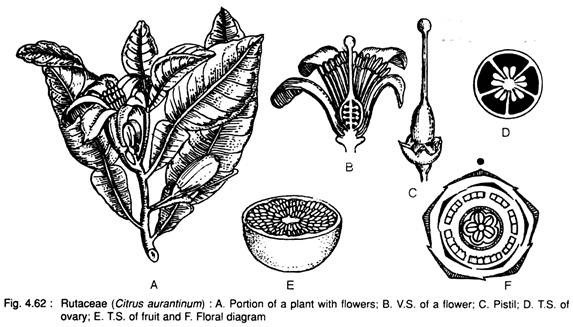
The plants of this family are important for fruits and medicines. A few also have ornamental value.
A. Fruits:
The family is very much important for its fruits.
Name of some important fruit plants are:
1. Citrus aurantitfolia (Lime).
2. C. aurantium (Orange, Kamala)
3. C. limon (Lemon).
4. C. maxima Merr. (syn. C. decumana L) (Shad-dock, Batabi-nebu).
5. C. media (Citron).
6. C. paradisi (Grape fruit, Loose skinned orange),
7. C. reticulata (Mandarin orange).
8. C. sinensis (Sweet orange, Mosambic).
In addition to the above, a few fruits of the other plants are used variously.
These are:
1. Aegle marmelos (Bael tree, Wood apple, Bael). The fruits are edible. The pulp of ripe fruits and boiled raw fruits are very useful to control dysentery and other stomach troubles.
2. Feronia elephantum (Elephant apple, Kath-bel). The ripe fruits are used to make chutney (pickle).
B. Medicines:
1. Peganum Harmala (Harmala):
The leaves are used for rheumatism. The extract of the seeds are used in fevers, asthma and rheumatism.
2. Toddalia Asiatica:
The extract of the root bark is used as antimalarial drug.
3. Zanthoxylum Armatum (Tejpat):
The plant is an insect repellant. Oil extracted from the fruits has an antiseptic properties and is used in tooth-paste and soap industries.
4. Z. Nitidum:
The roots are used in toothache.
5. Z. Limonella:
The fruits are very digestive.
C. Spices:
1. Murraya Koenigii (Curry-Leaf Plant):
The aromatic leaves are used for flavouring curries and other items mainly in southern part of India.
2. Zanthoxylum Limonella:
The leaves are used as condiments.
D. Ornamental Plants:
The following plants are grown as ornamentals:
1. Dictamnus albus.
2. Glycosmis pentaphylla.
3. Murraya paniculata (syn. M. exotica) (Orange jasmine, Kamini). Plants with white fragrant flower.
4. Ruta graveolens (Common rue).
5. Skimmia arborescens.
